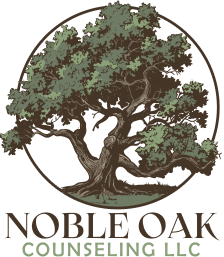Understanding Burnout
Burnout is more than just being tired. It’s a state of physical, emotional, and mental exhaustion caused by prolonged or repeated stress—especially in demanding roles like caregiving, parenting, helping professions, or high-pressure workplaces.
At Noble Oak Counseling, I see burnout show up in clients who once felt capable and motivated, but now describe themselves as numb, resentful, or completely depleted. Often, they’re carrying more than they realize—until their body and mind force them to stop.
Common Signs of Burnout
Recognizing burnout early can prevent deeper emotional distress. Some key signs include:
- Constant fatigue, even after rest
- Loss of motivation or interest in things you used to enjoy
- Difficulty concentrating or making decisions
- Irritability or emotional detachment
- Physical symptoms like headaches, stomach issues, or sleep disruption
- Feeling cynical or hopeless about work, relationships, or responsibilities
If these sound familiar, you’re not alone—and you’re not broken. Burnout is your system’s way of asking for help and change.
The Difference Between Stress and Burnout
While stress is a natural part of life, burnout happens when stress becomes chronic and unmanaged. Stress feels like too much—too many tasks, too many expectations. Burnout feels like not enough—no energy, no motivation, no hope.
Understanding this distinction can help you better identify what kind of support you need.
Root Causes of Burnout
Burnout is often fueled by a mix of external pressures and internal beliefs. Some contributing factors include:
- Taking on too much without breaks
- Perfectionism or people-pleasing tendencies
- Lack of control over your schedule or workload
- Feeling unsupported or isolated
- Chronic exposure to emotionally draining situations
In therapy, we often explore both the environmental triggers and the mindset patterns that make burnout more likely to occur—and harder to recover from.
How CBT Helps Manage Burnout and Stress
Cognitive Behavioral Therapy (CBT) is a well-established, evidence-based approach for addressing burnout and chronic stress. It works by helping individuals identify and change unhelpful thought patterns and behaviors that contribute to emotional exhaustion.
Key CBT Techniques for Burnout Recovery
- Cognitive Restructuring: This involves recognizing and challenging negative thought patterns—such as “I must be perfect” or “I can’t say no”—and replacing them with more balanced, realistic thoughts. This shift can reduce feelings of overwhelm and helplessness.
- Behavioral Activation: Burnout often leads to withdrawal from activities that once brought joy. CBT encourages re-engagement with these activities to boost mood and counteract fatigue.
- Relaxation Techniques: Practices like diaphragmatic breathing and progressive muscle relaxation help calm the body’s stress response, promoting physical and emotional recovery.
- Self-Monitoring: Keeping track of stressors, thoughts, and behaviors can increase awareness and highlight patterns that contribute to burnout, providing a foundation for change.
- Goal Setting and Problem-Solving: CBT assists in setting achievable goals and developing problem-solving skills, empowering individuals to manage stressors more effectively.
Research supports the effectiveness of CBT in reducing burnout symptoms. For instance, studies have shown that CBT can help individuals build resilience and develop coping strategies to manage stress more effectively.
Incorporating Mindfulness Practices: The Role of MBSR
In addition to CBT, Mindfulness-Based Stress Reduction (MBSR) offers a complementary approach to managing burnout and stress. Developed by Dr. Jon Kabat-Zinn at the University of Massachusetts Medical Center in 1979, MBSR is an eight-week program that combines mindfulness meditation, body awareness, and yoga to help individuals manage stress, pain, and illness.
Core Components of MBSR
- Mindfulness Meditation: Cultivating present-moment awareness without judgment.
- Body Scan Exercises: Systematically focusing attention on different parts of the body to develop awareness of bodily sensations.
- Gentle Yoga: Incorporating mindful movement to enhance body awareness and reduce tension.
- Group Discussions: Sharing experiences and insights to foster a supportive learning environment.
Benefits of MBSR
Research has demonstrated various benefits of MBSR, including:
- Reduced Stress and Anxiety: MBSR has been shown to lower stress levels and decrease symptoms of anxiety.
- Improved Emotional Well-Being: Participants often report enhanced mood and greater emotional regulation.
- Enhanced Cognitive Function: Mindfulness practices can improve attention, memory, and decision-making skills.
- Better Sleep Quality: MBSR techniques can lead to improved sleep patterns and reduced insomnia.
MBSR complements CBT by addressing the physiological and emotional aspects of stress, promoting a holistic approach to burnout recovery.
Stress Management Strategies That Actually Help
Burnout recovery isn’t about adding more tasks to your to-do list. It’s about creating space for rest, realignment, and recovery. Here are practical, research-supported strategies that make a difference:
1. Set Boundaries and Learn to Say “No”
Start by protecting your time and energy. If something drains you and isn’t essential, it’s okay to decline.
- Practice saying: “I’d love to, but I can’t take that on right now.”
- Block off non-negotiable time for rest, reflection, or low-effort activity.
2. Reclaim Rest—Not Just Sleep
Burnout recovery requires intentional rest, not just sleep. This might include:
- Unstructured time (doing nothing)
- Quiet hobbies (reading, drawing, walking)
- Social rest (time alone to recharge)
3. Practice Mindfulness and Grounding
Mindfulness calms the stress response and reconnects you to the present moment.
- Try deep breathing, body scans, or guided meditations
- Use grounding exercises like “5-4-3-2-1” to calm anxious thoughts
4. Reconnect with Purpose and Joy
Burnout drains your sense of meaning. Rebuilding it starts with small sparks of joy or purpose:
- What used to make you feel alive?
- What’s one thing that gives you a sense of meaning? Make space for those things—without guilt.
5. Challenge Perfectionism
Perfectionism often fuels burnout by creating unrealistic standards. CBT strategies can help you:
- Identify perfectionistic thoughts like “If I rest, I’m lazy”
- Reframe them into healthier beliefs: “Rest helps me show up better tomorrow”
When to Seek Support
You don’t have to “push through” burnout. In fact, doing so often deepens the problem. If you’re feeling exhausted, disconnected, or unsure how to get back to yourself, talking with a counselor can help you:
- Clarify what’s contributing to your burnout
- Identify boundaries and priorities
- Learn new ways to manage stress without guilt
If this article resonates with you, know that support is available. At Noble Oak Counseling, I help clients untangle stress, recover from burnout, and build a more sustainable way of living and working. If you’re ready to take that next step, I’d be honored to walk with you.








